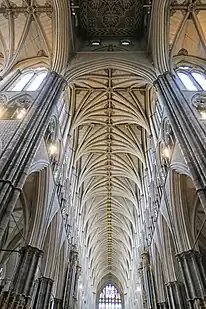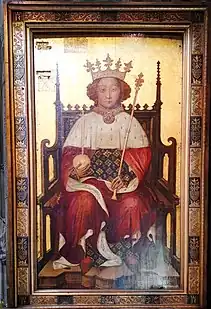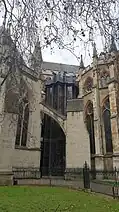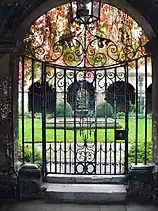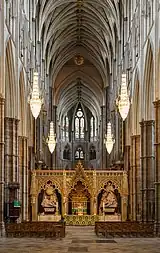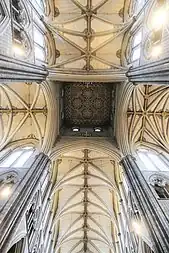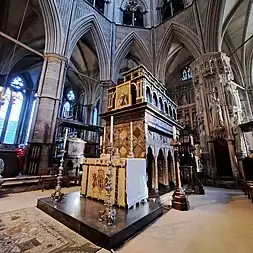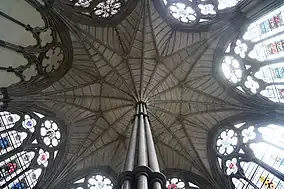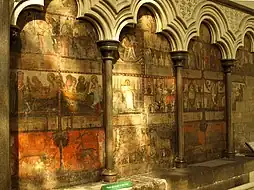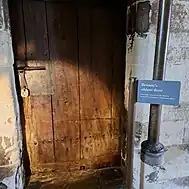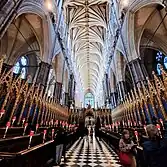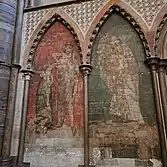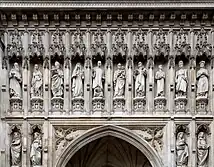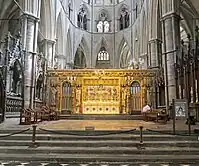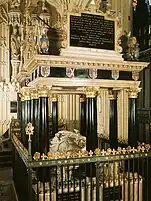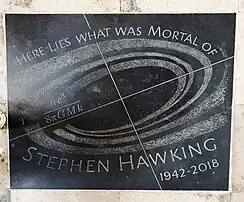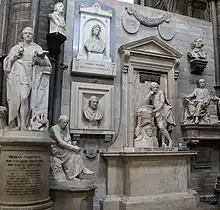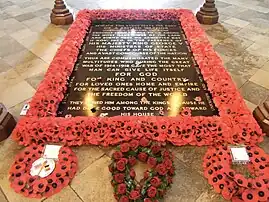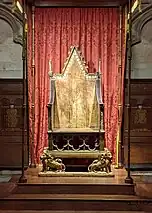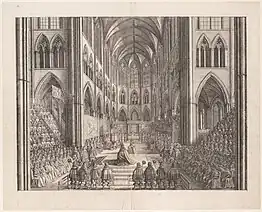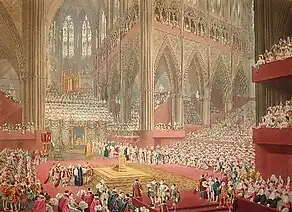Westminster Abbey
Westminster Abbey, formally titled the Collegiate Church of Saint Peter at Westminster, is an Anglican church in the City of Westminster, London, England. Since 1066, it has been the location of the coronations of 40 English and British monarchs,[5][6] and a burial site for 18 English, Scottish, and British monarchs.[7] At least 16 royal weddings have occurred at the abbey since 1100.[8]
| Westminster Abbey | |
|---|---|
| Collegiate Church of Saint Peter at Westminster | |
 Westminster Abbey's western façade | |
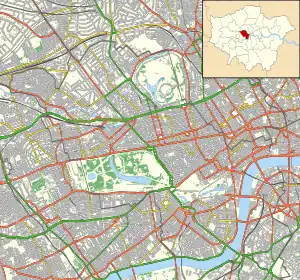 Westminster Abbey | |
| Location | Dean's Yard, London, SW1 |
| Country | England |
| Denomination | Church of England |
| Previous denomination | Roman Catholic Church |
| Churchmanship | High church |
| Website | www |
| History | |
| Status | Collegiate church |
| Founded | 960s–970s |
| Dedication | Saint Peter |
| Consecrated | 28 December 1065, 13 October 1269 |
| Architecture | |
| Functional status | Active |
| Heritage designation | UNESCO World Heritage Site |
| Designated | 1987 |
| Architectural type | Church |
| Style | Gothic |
| Groundbreaking | c. 1042 to 1052 |
| Specifications | |
| Nave width | 85 feet (26 m)[1] |
| Height | 101 feet (31 m)[1] |
| Floor area | 32,000 square feet (3,000 m2)[1] |
| Number of towers | 2 |
| Tower height | 225 feet (69 m)[1] |
| Materials | Reigate stone; Portland stone; Purbeck marble |
| Bells | 10 |
| Administration | |
| Diocese | Extra-diocesan (royal peculiar) |
| Clergy | |
| Dean | David Hoyle |
| Canon(s) | see Dean and Chapter |
| Laity | |
| Director of music | Andrew Nethsingha (Organist and Master of the Choristers) |
| Organist(s) | Peter Holder[2] (sub-organist) Matthew Jorysz[2] (assistant) |
| Organ scholar | Dewi Rees[2] |
| Coordinates | 51°29′58″N 00°07′39″W |
| Founded | 960s–970s[3] |
| Official name | Palace of Westminster, Westminster Abbey and Saint Margaret's Church |
| Type | Cultural |
| Criteria | i, ii, iv |
| Designated | 1987 (11th session) |
| Reference no. | 426 |
| Country | United Kingdom |
| Region | Europe and North America |
Listed Building – Grade I | |
| Official name | Westminster Abbey (The Collegiate Church of St Peter) |
| Designated | 24 February 1958 |
| Reference no. | 1291494[4] |
Although the origins of the church are obscure, there was certainly an abbey operating on the site by the mid-10th century, housing Benedictine monks.[9] The church got its first grand building in the 1060s under the auspices of the English king Edward the Confessor, who is buried inside.[10] Construction of the present church began in 1245 on the orders of Henry III.[11] The monastery was dissolved in 1559 and the church was made a royal peculiar—a Church of England church responsible directly to the sovereign—by Elizabeth I.[12] In 1987, the abbey, together with the Palace of Westminster and St. Margaret's Church, was designated a UNESCO World Heritage site because of its historic and symbolic significance.[13]
The Gothic architecture of the church is chiefly inspired by French and English styles from the 13th century,[14] although some sections of the church show earlier Romanesque styles,[15] or later Baroque,[16] and modern styles.[17] The Henry VII Chapel at the east end of the church is a typical example of Perpendicular Gothic architecture; the antiquarian John Leland said of it that it was orbis miraculum ("the wonder of the world").[18]
The abbey is the burial site of more than 3,300 people, many of prominence in British history: monarchs, prime ministers, poets laureate, actors, scientists, military leaders, and the Unknown Warrior.[19] Due to the fame of the figures buried there, artist William Morris described the abbey in 1900 as a "National Valhalla".[20]
History
Although historians agree that there was a monastery dedicated to St. Peter on the site prior to the 11th century, its exact origin is somewhat obscure. One legend claims that it was founded by the Saxon King of Essex Sæberht, and another that its founder was the fictional 2nd-century British king Lucius.[21] One tradition claims that a young fisherman on the River Thames had a vision of Saint Peter near the site. This seems to have been quoted as the origin of the salmon that Thames fishermen offered to the abbey, a custom still observed annually by the Fishmongers' Company.[22] The recorded origins of the abbey date to the 960s or early 970s, when Saint Dunstan and King Edgar installed a community of Benedictine monks on the site.[9] At that time, the location was an island in the middle of the River Thames called Thorn Ey.[23] The buildings from this time would have been wooden, and have not survived.[24]
11th century: Edward the Confessor's abbey

Between 1042 and 1052, Edward the Confessor began rebuilding St. Peter's Abbey to provide himself with a royal burial church. It was built in the Romanesque style and was the first church in England built on a cruciform floorplan.[26] The master stonemason for the project was Leofsi Duddason,[27] with Godwin and Wendelburh Gretsyd (meaning "fat purse") as patrons, and Teinfrith as "churchwright", probably meaning someone who worked on the carpentry and roof.[28] Endowments from Edward supported a community that increased from a dozen monks, during Dunstan's time, up to as many as 80.[29] The building was completed around 1060 and was consecrated on 28 December 1065, only a week before Edward's death on 5 January 1066.[10] A week later, he was buried in the church; nine years later, his wife Edith was buried alongside him.[30] His successor, Harold Godwinson, was probably crowned here, although the first documented coronation is that of William the Conqueror later that year.[31]
The only extant depiction of Edward's abbey is in the Bayeux Tapestry.[32] The foundations still survive under the present church, and above ground, some of the lower parts of the monastic dormitory survive in the undercroft, including a door said to come from the previous Saxon abbey. It was a little smaller than the current church, with a central tower.[33]
In 1103, thirty-seven years after his death, Edward's tomb was re-opened by Abbot Gilbert Crispin and Henry I, who discovered that his body was still in perfect condition. This was considered proof of his saintliness, and he was canonised in 1161.Two years later he was moved to a new shrine, during which time his ring was removed and placed in the abbey's collection.[34]
13th–14th centuries: Construction of the present church
The abbey became more closely associated with royalty from the second half of the 12th century, as kings increasingly used the nearby Palace of Westminster as the seat of their governments.[35] The abbot was also the lord of the manor in Westminster as a town of two to three thousand people grew around the abbey.[36] As a consumer and employer on a grand scale, the abbey helped fuel the town's economy, and relations with the town remained unusually cordial, but no enfranchising charter was issued during the Middle Ages.[37]
Westminster Abbey continued to be used as a coronation site, but after Edward the Confessor, no monarchs were buried there until Henry III began to rebuild it in the Gothic style as a shrine to venerate Edward, as a competitor to match the great French churches such as Rheims Cathedral and Sainte-Chapelle,[38] and as a burial place for himself and his family.[39] Construction began on 6 July 1245 under Henry's master mason, Henry of Reynes.[27] The first building stage included the entire eastern end, the transepts, and the easternmost bay of the nave. The Lady chapel, built from around 1220 at the extreme eastern end, was incorporated into the chevet of the new building, but has since been replaced by the Henry VII Chapel. Around 1253, Henry of Reynes was replaced by John of Gloucester, who was replaced by Robert of Beverley around 1260.[11] During the summer, there were up to 400 workers on the site at a time,[40] including stonecutters, marblers, stone-layers, carpenters, painters and their assistants, marble polishers, smiths, glaziers, plumbers, and general labourers.[41] From 1257, Henry III held assemblies of local representatives in Westminster Abbey's chapter house, which were a precursor to the House of Commons. Henry III also commissioned the Cosmati pavement in front of the High Altar.[42] Further building work carried the nave an additional five bays, bringing it to one bay west of the choir. Here, construction stopped in about 1269. By 1261 alone Henry had spent £29,345 19s 8d on the abbey, and the final sum may have been in the region of £50,000.[43] A consecration ceremony was held on 13 October 1269, during which the remains of Edward the Confessor were moved to their present location at the shrine behind the main altar,[44] but after Henry's death and burial in the abbey in 1272, construction did not resume and Edward the Confessor's old Romanesque nave remained attached to the new building for over a century.[11]
In 1296, Edward I captured the Scottish coronation stone, the Stone of Scone, and had a Coronation Chair made to hold it, which he entrusted to the abbot at Westminster Abbey.[45] In 1303, the small crypt underneath the chapter house was broken into and a great deal of the king's treasure stolen. It was thought that the thieves must have been helped by the abbey monks, fifty of whom were subsequently imprisoned in the Tower of London.[46]
From 1376, Abbot Nicholas Litlyngton[47] and Richard II donated large sums to finish the church, and the remainder of the old nave was pulled down and rebuilding recommenced, with his mason, Henry Yevele, closely following the original (and by then outdated) design.[48] During the Peasants' Revolt of 1381, Richard prayed at Edward the Confessor's shrine for "divine aid when human counsel was altogether wanting" before meeting the rebels at Smithfield. To this day, the abbey holds his full-length portrait, the earliest of an English king, on display near the west door.[49] However, building work was not to be fully completed for many years. Henry V, disappointed with the abbey's unfinished state, gave extra funds towards the rebuilding, and in his will left instructions for a chantry chapel to be built over his tomb, which can be viewed from ground level today.[50] Building work finally reached the end of the nave, finishing with the west window, in 1495.[51]
Under Henry VII, the 13th-century Lady Chapel (known as the "Henry VII Chapel" or the "Lady Chapel") was demolished and rebuilt in a Perpendicular Gothic style. Work was begun in 1503 and the chapel was finished c.1519.[48] Henry's original reason for building such a grand chapel was to have a place suitable for the burial of another saint alongside the Confessor, as he planned on having Henry VI canonised.[52] The Pope asked Henry VII for a large sum of money to achieve sainthood for his predecessor, which he was not willing to hand over, and so instead Henry VII is buried in the centre of the chapel with his wife, Elizabeth of York.[53]
A view of the abbey dated 1532 shows a lantern tower above the crossing,[54] but it is not shown in any later depiction. It is unlikely that the loss of this feature was caused by any catastrophic event, but structural failure seems more likely.[55] However, other sources maintain that a lantern tower was never built. The current squat pyramid dates from the 18th century; the painted wooden ceiling below it was installed during repairs to World War II bomb damage.[56]
In the early 16th century, a project began under Abbot John Islip to add two towers to the western end of the church. These were partially built up to the roof level of the church when building work stopped because of the uncertainty caused by the English Reformation.[57]
16th–17th centuries: Dissolution and Reformation
In the 1530s, Henry VIII broke away from the authority of the Catholic Church in Rome and seized control of England's monasteries, including Westminster Abbey, beginning the English Reformation.[58] In 1535, when the king's officers assessed the abbey's funds, their annual income was £3,000.[59] Henry's agents removed many relics, saints' images, and treasures from the abbey: the golden feretory that housed the coffin of Edward the Confessor was melted down, and the monks even hid his bones to save them from destruction.[60] Henry VIII assumed direct control of the abbey in 1539 and granted it the status of a cathedral by charter in 1540, simultaneously issuing letters patent establishing the Diocese of Westminster. By granting the abbey cathedral status, Henry VIII gained an excuse to spare it from the destruction or dissolution which he inflicted on most English abbeys during this period.[61] The abbot, William Benson, instead became dean of the cathedral, while the prior and five of the monks were among the twelve newly created canons.[62]
The Westminster diocese was dissolved in 1550, but the abbey was recognised (in 1552, retroactively to 1550) as a second cathedral of the Diocese of London until 1556.[63] The already-old expression "robbing Peter to pay Paul" may have been given a new lease of life when money meant for the abbey, which is dedicated to Saint Peter, was diverted to the treasury of St. Paul's Cathedral.[64]
The abbey saw the return of Benedictine monks under the Catholic Mary I, but they were again ejected under Elizabeth I in 1559.[12] In 1560, Elizabeth re-established Westminster as a "royal peculiar" – a church of the Church of England responsible directly to the sovereign, rather than to a diocesan bishop – and made it the Collegiate Church of St. Peter (that is, a non-cathedral church with an attached chapter of canons, headed by a dean). From this date onwards, although the building is still called an abbey, it is, strictly speaking, simply a church.[65] Elizabeth also re-founded Westminster School,[66] providing for 40 students known as the King's (or Queen's) Scholars and their schoolmasters. The King's Scholars have the duty of shouting Vivat Rex or Vivat Regina ("Long live the King/Queen") during the coronation of a new monarch. To this day, the dean of Westminster Abbey remains the chair of the school governors.[44]
In the early 17th century, the abbey hosted two of the six companies of churchmen, led by Lancelot Andrewes, Dean of Westminster, who translated the King James Version of the Bible.[67]
In 1642, the English Civil War broke out between Charles I and his own Parliament. The Dean and Chapter fled the abbey at the outbreak of war, and were replaced by priests loyal to Parliament.[68] The abbey itself suffered damage during the war, when altars, stained glass, the organ and the crown jewels were damaged or destroyed.[69] Lord Protector Oliver Cromwell was given an elaborate funeral there in 1658, only for a body thought to be Cromwell's to be disinterred in January 1661 and posthumously hanged from a gibbet at Tyburn.[70] In 1669, the abbey was visited by the diarist Samuel Pepys, who saw the body of the 15th-century queen Catherine de Valois. She had been buried in the 13th-century Lady Chapel in 1437, but was exhumed during building work for the Henry VII Chapel and not reburied in the intervening 150 years. Pepys leaned into the coffin and kissed her on the mouth, writing "This was my birthday, thirty-six years old and I did first kiss a queen." She has since been re-interred close to her husband, Henry V.[71] In 1685, during preparations for the coronation of James II, a workman accidentally put a scaffolding pole through the coffin of Edward the Confessor. A chorister, Charles Taylour, pulled a cross on a chain out of the coffin and gave it to the king, who then gave it to the Pope. Its whereabouts today are unknown.[72]
18th–19th centuries: Western towers constructed
At the end of the 17th century, the architect Christopher Wren was appointed the abbey's first Surveyor of the Fabric, and began a project to restore the exterior of the church,[57] which was continued by his successor, William Dickinson.[69] After over two hundred years, the abbey's two western towers were finally built between 1722 and 1745 by Nicholas Hawksmoor and John James, constructed from Portland stone.[73]
During an earthquake in 1750, the top of one of the piers on the north side fell, with the iron and lead that had fastened it. Several houses fell in, and many chimneys were damaged. Another shock had been felt during the preceding month.[74]
On 11 November 1760, the funeral of George II was held at the abbey and the king was interred next to his late wife, Caroline of Ansbach. He left instructions for the sides of his and his wife's coffins to be removed so that their remains could mingle.[75] He was the last monarch to be buried in the abbey.[76] At around the same time, the tomb of Richard II developed a hole through which visitors could put their hand. Several of his bones went missing, including a jawbone, which was taken by a boy from Westminster School and kept in the family until 1906, when it was returned to the abbey.[77]
In the 1830s, the previous screen dividing the nave from the choir, which had been designed by Nicholas Hawksmoor, was replaced by one designed by Edward Blore. The screen contains the monuments for the scientist Isaac Newton and the military general James Stanhope.[78]
Further rebuilding and restoration occurred in the 19th century under the architect George Gilbert Scott, who rebuilt the façade of the north transept, changing the rose window and porches on that side,[79] and designed a new altar and reredos for the crossing.[80] A narthex (a portico or entrance hall) for the west front was designed by Sir Edwin Lutyens in the mid-20th century but was not built.[81]
20th century
.jpg.webp)
The abbey saw "Prayers For Prisoners" suffragette protests in 1913 and 1914. Protesters attended services and interrupted proceedings by chanting "God Save Mrs. Pankhurst" and praying for suffragette prisoners. In one protest, a woman chained herself to her chair during a sermon by the Archbishop of Canterbury.[16] On 11 June 1914, a bomb planted by suffragettes of the Women's Social and Political Union exploded inside the abbey.[82] The abbey was busy with visitors, with around 80–100 people in the building at the time of the explosion.[83][84] Some were as close as 20 yards (18 m) from the bomb and the explosion caused a panic for the exits, but no serious injuries were reported.[84] The bomb blew off a corner of the Coronation Chair.[82] It also caused the Stone of Scone to break in half, although this was not discovered until 1950, when four Scottish nationalists broke into the church to steal the stone and return it to Scotland.[82] The bomb had been packed with nuts and bolts to act as shrapnel.[84] The event was part of a campaign of bombing and arson attacks carried out by suffragettes nationwide between 1912 and 1914.[85] Churches were a particular target, as it was believed that the Church of England was complicit in reinforcing opposition to women's suffrage – 32 churches were attacked nationwide between 1913 and 1914.[84][86] Coincidentally, at the time of the explosion, the House of Commons only 100 yards (90 m) away was debating how to deal with the violent tactics of the suffragettes.[84] Many in the Commons heard the explosion and rushed to the scene.[84] Two days after the Westminster Abbey bombing, a second suffragette bomb was discovered before it could explode in St. Paul's Cathedral.[85]
Westminster suffered minor damage during the Blitz on 15 November 1940. On the night of 10 May 1941 and the early morning of the 11th, the Westminster Abbey precincts and roof were hit by incendiary bombs.[87] Although the Auxiliary Fire Service and the abbey's own fire-watchers were able to stop the fire spreading to the whole of the church, the deanery and three residences of abbey clergy and staff were badly damaged, and the lantern tower above the crossing collapsed, leaving the abbey open to the sky.[88] The cost of the damage was estimated at £135,000.[89] Some damage can still be seen in the RAF Chapel, where a small hole in the wall was created by a bomb that fell outside the chapel.[90]
Because of its outstanding universal value, the abbey was designated a UNESCO World Heritage Site in 1987, together with the nearby Palace of Westminster and St. Margaret's Church.[13]
In 1997, the abbey, which was then receiving approximately 1.75 million visitors each year, began charging admission fees to visitors at the door[91] (although a fee for entering the eastern half of the church had existed prior to 1600).[92]
21st century
In June 2009 the first major building work in 250 years was proposed.[93] A corona – a crown-like architectural feature – was suggested to be built around the lantern over the central crossing, replacing an existing pyramidal structure dating from the 1950s.[94] This was part of a wider £23m development of the abbey completed in 2013.[93] On 4 August 2010, the Dean and Chapter announced that, "after a considerable amount of preliminary and exploratory work", efforts toward the construction of a corona would not be continued.[95]
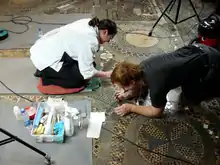
The Cosmati pavement was re-dedicated by the Dean at a service on 21st May 2010 after undergoing a major cleaning and conservation programme.[96] On 17 September 2010, Pope Benedict XVI became the first pope to set foot in the abbey,[97] and on 29 April 2011, the wedding of Prince William and Catherine Middleton took place at the abbey.[98]
In 2018, the Queen's Diamond Jubilee Galleries were created in the medieval triforium. This is a display area for the abbey's treasures in the galleries high up around the sanctuary. A new Gothic access tower with lift was designed by the abbey architect and Surveyor of the Fabric, Ptolemy Dean.[99][17]
In 2020, a 13th-century sacristy was uncovered in the grounds of the abbey as part of an archaeological excavation. The sacristy was used by the monks of the abbey to store objects used in the Mass, such as vestments and chalices. Also on the site were hundreds of burials, mostly of abbey monks.[100]
On 10 March 2021, a vaccination centre opened in Poets' Corner to administer doses of COVID-19 vaccines.[101]
Architecture
.jpg.webp)
The building is chiefly Reigate stone,[102] and is mostly built in a Geometric Gothic style. The church has an eleven-bay nave with aisles, transepts, and a chancel with ambulatory and radiating chapels. The height of the building is supported with two tiers of flying buttresses. The western end of the nave and the west front were designed by Henry Yevele in a Perpendicular Gothic style. The Henry VII Chapel was built in a late Perpendicular style, probably by Robert and William Vertue. The west towers were designed by Nicholas Hawksmoor and blend Gothic with Baroque style.[16]
The present Westminster Abbey is largely based on French Gothic styles, especially those found at Reims Cathedral, rather than the contemporaneous English Gothic styles. For example, the English Gothic style favours large and elaborate towers, while Westminster Abbey did not have any towers until the 18th century. It is also more similar to French churches than English ones in terms of its ratio of height to width: Westminster Abbey has the highest nave of any Gothic church in England, and the nave is much narrower than any medieval English church of a similar height. Instead of a short, square, eastern end, as was the English fashion, Westminster Abbey has a long, rounded apse, and it also has chapels radiating from the ambulatory, which is typical of a French Gothic style. However, there are also distinctively English elements, such as the use of materials of contrasting colours, like Purbeck marble and white stone in the crossing.[14]
The northern door features an elaborately-carved tympanum, leading it to acquire the nickname "Solomon's porch" as a reference to the legendary temple in Jerusalem.[103]
The abbey retains its 13th- and 14th-century cloisters, which would have been one of the busiest parts of the church when it was a monastery. The west cloister was used for the teaching of novice monks; the north for private study. The south cloister led to the refectory, and the east to the chapter house and dormitory.[15] In the south-west corner of the cloisters is a cellarium used by the monks to store food and wine, which is today the abbey café.[104] The abbey also contains a Little Cloister, on the site of the monks' infirmary. The Little Cloister dates from the end of the 17th century and contains a small garden with a fountain in the centre.[105] A passageway from the Little Cloister leads to College Garden, which has been in continuous use for 900 years, beginning as the medicine garden for the monks of the abbey and now overlooked by canon's houses and the dormitory for Westminster School.[106]
The newest part of the abbey is the Weston Tower, finished in 2018 and designed by Ptolemy Dean. It sits between the chapter house and the Henry VII Chapel, and contains a lift shaft and spiral staircase to allow public access to the triforium, which contains the Queen's Diamond Jubilee Galleries.[107] The tower has a star-shaped floorplan and leaded windows with an elaborate crown rooftop. The lift shaft inside is faced with 16 kinds of stone from the abbey's history, including Purbeck marble, Reigate stone, and Portland stone. The project took five years and cost £22.9m. The galleries were designed by McInnes Usher McKnight.[17]
Interior
Inside, the church has Purbeck marble piers and shafting. The vaulting of the roof is quadripartite, with ridge ribs and bosses,[16] and at 102 feet (31 m), it is one of the highest church vaults in Britain.[26] To fit in as many guests as possible during coronations, the transepts were designed to be unusually long[108] and the choir placed to the east of the crossing rather than to the west; a feature also seen in Rheims Cathedral.[109]
The nave was built slowly over the course of many centuries from the east end to the west end, and yet, because generations of builders stuck to the original design, it has a unified style. The only marker to show the long gap in building work between 1269 and 1376 is on the spandrels above the arches, which towards the earlier east end are decorated with diaper-work, and towards the west end, built later, are plain.[110] Above the crossing, in the centre of the church, is a roof lantern, destroyed by a bomb in 1941 and restored by the architect Stephen Dykes Bower in 1958.[111] In the choir aisles, shields of donors to the 13th- and 14th-century rebuilding are carved and painted in the spandrels of the arcade.[112] At the eastern end of the nave is a large screen separating the nave from the choir, made of 13th-century stone but totally reworked by Edward Blore in 1834 and with paintwork and gilding by Bower in the 1960s.[110]
Behind the main altar, in the holiest part of the church, lies the shrine and tomb of Edward the Confessor. Saints' shrines were once common in English medieval churches, but most were destroyed during the English Reformation, and Edward is the only major English saint whose body still occupies his shrine.[113] Arranged around him in a horseshoe shape are a series of tombs of medieval kings and their queens: Henry III, Eleanor of Castile, Edward I, Philippa of Hainault, Edward III, Anne of Bohemia, and Richard II, with Henry V in the centre of the horseshoe, at the eastern end.[114] Henry III's tomb was originally covered in gold mosaic and coloured stone,[115] but these have since been picked off by generations of tourists below the level of hand height.[116] Above Henry V's tomb, at a mezzanine level hanging over the ambulatory, is a chantry chapel built by the mason John Thirske, decorated with many sculpted figures, including Henry V riding a horse, and being crowned in the abbey.[117] At the western end, the shrine is separated from the main church by a stone reredos, closing off the shrine as a semi-private space.[114] The screen depicts episodes from the saint's life, including his birth and the building of the abbey.[118] The shrine is closed to the public except for special events.[119]
The abbey includes side chapels radiating from the ambulatory. Many were originally included in the 13th-century rebuilding as special altars dedicated to individual saints, and many of the chapels still bear saints' names, e.g. St. Nicholas, St. Paul, etc. From the time of the English Reformation, saints' cults were no longer orthodox, and so instead the chapels were repurposed as places for extra burials and monuments.[120] In the north ambulatory are the Islip Chapel, the Nurses' Memorial Chapel (sometimes called the "Nightingale Chapel"), the Chapel of Our Lady of the Pew,[121] the Chapel of St. John the Baptist, and St. Paul's Chapel.[122] The Islip Chapel is named after Abbot John Islip, who commissioned it in the 16th century. The screen inside is decorated with a visual pun on his name, showing an eye and a boy falling from a tree (eye-slip).[123] There are further chapels within the eastern aisle of the north transept, named after (from south to north) St. John the Evangelist, St. Michael, and St. Andrew.[124] In the south ambulatory are the chapels of St. Nicholas, St. Edmund, and St. Benedict.[125]
The footprint of the south transept is by necessity smaller than the northern one, because the 13th-century builders butted against the pre-existing 11th-century cloisters. To make the transepts match, the south transept is built hanging over the western cloister. This allowed the creation of a room above the cloisters used to store the abbey muniments.[126] In the south transept is the chapel of St. Faith, built c.1250 to serve as the vestry for the abbey monks. On the east wall is a painting of her, made c.1290–1310, showing her holding the grid-iron she was roasted to death on.[127]
Chapter house and Pyx Chamber
The chapter house was used by the abbey monks for daily meetings where they would hear a chapter of the Rule of St. Benedict and be given their instructions for the day from the abbot.[128] It was also used by the King's Great Council and the House of Commons as a meeting chamber during the 14th century.[129] The chapter house was built concurrently with the eastern parts of the abbey under Henry III, between about 1245 and 1253,[79] and is one of the largest in Britain, measuring nearly 60 feet (18 m) across.[128] For 300 years after the English Reformation, it was used to store state records, until these were moved to the Public Record Office in 1863.[130] It was restored by George Gilbert Scott in 1872. The entrance is approached from the east cloister and includes a double doorway with a large tympanum above.[79] Inner and outer vestibules lead to the octagonal chapter house. It is built in a Geometrical Gothic style with an octagonal crypt below and a pier of eight shafts carrying the vaulted ceiling. Around the sides are blind arcading and numerous stone benches, above which are large, four-light, quatre-foiled windows.[79] The exterior includes flying buttresses added in the 14th century and a leaded tent-lantern roof on an iron frame designed by Scott.[129]
The walls of the chapter house are decorated with 14th- and 15th-century paintings representing the Apocalypse, the Last Judgement, and birds and animals.[131] The depiction of the Apocalypse is the only example in England.[132] The chapter house also has an original mid-13th-century tiled floor. A wooden door within the vestibule was made with a tree felled 1032–1064[133] and is one of the oldest in Britain.[131] It may have been the door to the 11th-century chapter house in Edward the Confessor's abbey, and was re-used as the door to the Pyx Chamber in the 13th century. Today it leads to an office.[128]
The adjoining Pyx Chamber formed the undercroft of the monks' dormitory. It dates to the late 11th century and was used as a monastic and royal treasury. The outer walls and circular piers date from the 11th-century; several of the capitals were enriched in the 12th century, and the stone altar added in the 13th century. The term pyx refers to the boxwood chest in which coins were held and presented to a jury during the Trial of the Pyx, in which newly minted coins were presented to ensure they conformed to the required standards.[15]
The chapter house and Pyx Chamber at Westminster Abbey are in the guardianship of English Heritage, but under the care and management of the Dean and Chapter of Westminster.[129]
Henry VII Chapel
| External video | |
|---|---|
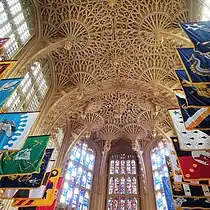 | |
The Henry VII Lady Chapel, also known simply as the Henry VII Chapel, is a large Lady chapel at the far eastern end of Westminster Abbey, paid for by the will of King Henry VII.[135] The chapel is built in a very late Perpendicular Gothic style, the magnificence of which caused the English poet John Leland to call it the orbis miraculum (the wonder of the world).[18] The tombs of several monarchs, including Edward V, Henry VII, Edward VI, Mary I, Elizabeth I, James I, Charles II, George II and Mary, Queen of Scots, are found in the chapel.[136]
The chapel is noted for its pendant and fan vault ceiling, probably designed by William Vertue, which the writer Washington Irving said was "achieved with the wonderful minuteness and airy security of a cobweb". The interior walls are densely decorated with carvings, including 95 statues of saints. Many statues of saints in England were destroyed in the 17th century, so these are a rare survival.[90] From the outside, the chapel is surrounded by flying buttresses, each taking the form of a polygonal tower topped with a cupola. At the centre of the chapel is the tomb of Henry VII and his wife, Elizabeth of York, made by the sculptor Pietro Torrigiano,[18] who fled to England from Italy after getting into a fight with the artist Michaelangelo and breaking his nose.[90]
The chapel has within it further sub-chapels radiating from the main structure. One of these to the north contains the tombs of Mary I and Elizabeth I, both coffins being within Elizabeth's monument; and another to the south contains the tomb of Mary, Queen of Scots. Both monuments were commissioned by James I, the successor of Elizabeth to the English throne and the son of Mary, Queen of Scots.[137] At the far eastern end is the RAF Chapel, with a stained-glass window dedicated to those who died in the Battle of Britain in 1940.[90]
The chapel has also been the mother church of the Order of the Bath since 1725, and the banners of members hang above the stalls.[138] The stalls themselves retain their medieval misericords – small ledges for monks to perch on during services, often decorated with varied and humorous carvings.[139]
Monastic buildings
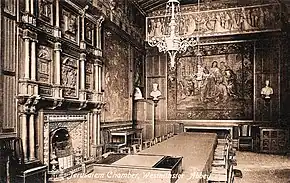
Many of the rooms used by the monks still exist, only repurposed. The dormitory was turned into a library and a school room, and their offices have been converted into houses for the clergy.[140] The abbot had his own lodgings and ate separately from the rest of the monks. The abbot's lodgings still exist but are now used by the Dean of Westminster, and are probably the oldest continuously occupied residence in London.[141] They include the Jericho Parlour, built c.1520 and covered in wooden linenfold panelling, and the Jerusalem Chamber, which was the abbot's drawing room. The windows in the Jerusalem Chamber are stained glass and may have come from the original Lady Chapel which existed prior to the building of the Henry VII Chapel. The abbot also had a grand dining hall complete with minstrels' gallery, now used by Westminster School.[142] The prior also had his own household separate from the monks, the remains of which form the core of Ashburnham House in Little Dean's Yard, now also part of Westminster School.[143]
Artworks and treasures
In the nave and transepts are sixteen crystal chandeliers made of handblown Waterford glass. They were designed by A. B. Read and Stephen Dykes Bower, and donated by the Guinness family in 1965 to commemorate the abbey's 900th anniversary.[144] The choir stalls were designed by Edward Blore in 1848.[111] Some stalls are assigned to high commissioners of countries in the Commonwealth of Nations.[145]
Beyond the crossing to the west is the sacrarium, which contains the high altar. The abbey holds the 13th-century Westminster Retable, which is thought to be the altarpiece from Henry III's 13th-century church, in its collections.[146] The present high altar and screen were designed by George Gilbert Scott between 1867 and 1873, and contain sculptures of Moses, St. Peter, St. Paul and King David made by the sculptor H. H. Armistead, and a mosaic of the Last Supper by the designer J. R. Clayton and the mosaic-maker Antonio Salviati.[147]
The south transept contains wall paintings, made c.1300, which Richard Jenkyns calls "the grandest of their time remaining in England".[148] They depict Thomas the Apostle viewing Christ's stigmata and St. Christopher carrying the Christ child, and were discovered in 1934 behind two monuments.[149] 14th-century paintings were also discovered during cleaning in 1923 on the backs of the sedilia, or seats used by priests on either side of the high altar. On the south side, there are three figures: Edward the Confessor, the angel Gabriel and the Virgin Mary; and on the north side there are two kings, possibly Henry III and Edward I.[150] They were walled off during the Commonwealth period by order of Parliament.[151]
Over the Great West Door are ten statues of 20th-century Christian martyrs of various denominations, made by the abbey's craftsmen in 1998.[152] Those commemorated are Maximilian Kolbe, Manche Masemola, Janani Luwum, Grand Duchess Elizabeth Feodorovna, Martin Luther King Jr., Óscar Romero, Dietrich Bonhoeffer, Esther John, Lucian Tapiedi, and Wang Zhiming.[153][154]
From the chapter house is a doorway leading to the abbey's library, built as a dormitory for the monks and used as a library since the 16th century. The collection consists of around 16,000 volumes. Next to the library is the Muniment Room, where the abbey's store of historic archives is kept.[130]
Cosmati pavement

At the crossing, in front of Edward the Confessor's shrine and the main altar, is the Cosmati pavement, a 700-year-old tiled floor made of almost 90,000 pieces of coloured glass and stone.[155] It is where coronations take place in the abbey,[156] and measures 24 feet and 10 inches square.[155]
The floor is named after the Cosmati family in Rome who were known for such work.[42] It was commissioned by Richard Ware, who travelled to Rome in 1258 when he became Abbot, and returned with stone and artists. The porphyry used was originally quarried as far away as Egypt, and was presumably brought to Italy during the days of the Roman Empire. When it was made, it was surrounded by an inscription in brass letters, since lost, written in Latin, giving the name of the artist as Odericus,[157] probably referring to designer Pietro di Oderisio or his son.[158] As opposed to traditional mosaic work, the pieces are not cut to a uniform size, being instead made with a technique known as opus sectile ("cut work").[159] It is unique among all Cosmati floors in Europe for its use of dark Purbeck marble trays forming bold borders in place of the more typical white marble.[159] The Cosmati Pavement influenced later floor treatments at St George's Chapel, Windsor Castle, Canterbury Cathedral,[160] and the stately architecture of later buildings including Banqueting House and Soulton Hall.[161]
The pavement's design has multiple layers of symbolism,[160][162] and has been linked to the Classical philosophy and geometry of Plato and particularly the geometry of the rhombic dodecahedron, serving as a geometric allegory for diversity, society, kingship and good governance.[163] Together with the spiral columns of the nearby shrine of Edward the Confessor also installed by Henry III, its resemblance to the floorplan and dimensions of the 8th-century Anglo-Saxon Mercian royal baptistry and mausoleum at Repton has also been noted.[164][165] An inscription originally around the edge, since lost, predicts the end of the world 19,863 years after its creation.[166] The pavement is depicted in the 16th-century painting The Ambassadors by Hans Holbein.[115]
Stained glass
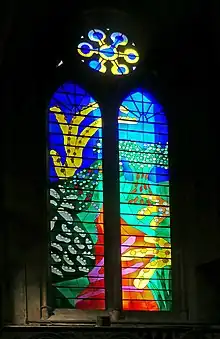
The 13th-century abbey's windows would have been filled with stained glass, but much of this was destroyed in the English Civil War and the Blitz and replaced with clear, plain glass. Since the 19th century, new stained glass has replaced clear glass, designed by artists such as Ninian Comper (on the north side of the nave), Hugh Easton and Alan Younger (in the Henry VII Chapel).[167]
The north rose window was designed by James Thornhill and made by Joshua Price in 1722 and shows Christ, the apostles (not including Judas Iscariot), and the Four Evangelists. In the centre is the Bible. The window was restored by J. L. Pearson in the 19th century, during which the feet of the figures were cut off.[168] Thornhill also designed the great west window, which shows the Biblical figures of Abraham, Isaac and Jacob, with representatives of the Twelve Tribes of Israel underneath.[169]
In the Henry VII Chapel, the west window was designed by John Lawson and unveiled in 1995. It depicts coats of arms and cyphers of Westminster Abbey's benefactors, in particular John Templeton, whose coat of arms is depicted prominently in the lower panel. In the centre are shown the arms of Elizabeth II. The central east window is designed by Alan Younger and was unveiled in 2000. It is dedicated to the Virgin Mary. It depicts the Hale Bopp comet, which was passing over the artist's house at the time, as the star of Bethlehem. The donors of the window, Lord and Lady Harris of Peckham, are shown kneeling at the bottom.[170]
In 2018, the artist David Hockney unveiled a new stained-glass window for the north transept, designed to celebrate the reign of Elizabeth II. It shows a countryside scene inspired by his native Yorkshire, with hawthorn blossoms and blue skies. Hockney used an iPad to design the window to replicate the backlight that comes through stained glass.[171]
The Queen's Diamond Jubilee Galleries
The Westminster Abbey Museum was located in the 11th-century vaulted undercroft beneath the former monks' dormitory. This is one of the oldest areas of the abbey, dating almost to the foundation of the church by Edward the Confessor in 1065. This space had been used as a museum since 1908[172] but was closed to the public in June 2018, when it was replaced as a museum by the Queen's Diamond Jubilee Galleries, high up in the abbey's triforium, and accessed by the new Weston Tower, enclosing a lift and stairs.[99]
The exhibits include a set of life-size effigies of English and British monarchs and their consorts, originally made to lie on the coffin in the funeral procession or to be displayed over the tomb. The effigies date from the 14th to the 18th century, and some include original clothes.[173]
On display in the galleries is a portrait of the Queen called The Coronation Theatre, Westminster Abbey: A Portrait of Her Majesty Queen Elizabeth II, painted by the artist Ralph Heimans, depicting the monarch standing on the Cosmati pavement of Westminster Abbey, where she was crowned in 1953.[174] Other exhibits include a model of an unbuilt tower, designed by Christopher Wren; a paper model of the abbey showing Queen Victoria's 1837 coronation; and the wedding licence of Prince William and Catherine Middleton, who were married in the abbey in 2011.[17]
Burials and memorials
From the death of Henry III in 1272 until the death of George II in 1760, most kings and queens were buried in the abbey. Monarchs buried there include Edward the Confessor, Henry III, Edward I, Edward III, Richard II, Henry V, Edward V, Henry VII, Edward VI, Mary I, Mary Queen of Scots, Elizabeth I, James I, Charles II, Mary II, William III, Queen Anne, and George II.[7] Elizabeth and Mary, Queen of Scots were the last monarchs to be buried with full tomb effigies; monarchs buried after them are commemorated in the abbey with simple inscriptions.[175] Most monarchs after George II have been buried either in St. George's Chapel, Windsor or at the Frogmore Royal Burial Ground to the east of Windsor Castle.[176][177]
For much of the abbey's history, most of the people buried there besides monarchs were people with a connection to the church – either ordinary locals or the monks of the abbey itself, who were generally buried without surviving markers.[178] Since the 18th century, it has become a prestigious honour for any British person to be buried or commemorated in the abbey.[179] The practice of burying national figures in the abbey began under Oliver Cromwell with the burial of Admiral Robert Blake in 1657 (although he was subsequently reburied outside),[180] and spread to include generals, admirals, politicians, doctors and scientists.[179] It was much boosted by the lavish funeral and monument of Isaac Newton, who died in 1727.[179]
In 1864, Arthur Penrhyn Stanley was appointed dean of the abbey, and was very influential in turning it into a "national church". He invited popular preachers to draw in large congregations, and attracted crowds by arranging for celebrities of the day to be buried in the abbey, such as the writer Charles Dickens, the explorer David Livingstone, and the scientist Charles Darwin — even when those people had expressed wishes to be buried elsewhere.[181]
Politicians buried in the abbey include Pitt the Elder, Charles James Fox, Pitt the Younger, William Gladstone, and Clement Attlee. A cluster of scientists surrounds the tomb of Isaac Newton, including Charles Darwin and Stephen Hawking. Actors include David Garrick, Henry Irving, and Laurence Olivier. Musicians tend to be buried in the north aisle of the nave, and include Muzio Clementi, Henry Purcell, and Ralph Vaughan Williams. George Frideric Handel is buried in Poets' Corner.[182]
During the early 20th century, it became increasingly common to bury cremated remains rather than coffins in the abbey. In 1905, Henry Irving was cremated and his ashes buried in Westminster Abbey, thereby becoming the first person to be cremated before interment at the abbey.[183] The majority of modern interments are of cremated remains, but some burials still take place, such as that of Frances Challen, wife of Sebastian Charles, Canon of Westminster, who was buried alongside her husband in the south choir aisle in 2014.[184] Members of the Percy family have a family vault, the Northumberland Vault, in St Nicholas' Chapel within the abbey.[185]
Poets' Corner
The south transept of the church is nicknamed Poets' Corner because of its high concentration of burials of, and memorials to, poets and writers. The first was Geoffrey Chaucer, buried around 1400, who was employed as Clerk of the King's Works and had apartments in the abbey. Nearly 200 years later in 1599, a second poet, Edmund Spenser, who was local to the abbey, was buried nearby. However, the idea of a Poets' Corner did not fully crystallise until the 18th century, when memorials were established to writers buried elsewhere, such as William Shakespeare and John Milton. Since then, writers buried in Poets' Corner include John Dryden, Alfred, Lord Tennyson, Charles Dickens, and Rudyard Kipling. However, not all writers buried in the abbey are in the south transept: Ben Jonson is buried standing upright in the north aisle of the nave, and Aphra Behn in the cloisters.[186]
The Unknown Warrior
On the floor, just inside the Great West Door, in the centre of the nave, is the grave of The Unknown Warrior, an unidentified soldier killed on a European battlefield during the First World War. Although many countries have adopted the tradition of a Tomb of the Unknown Soldier or Warrior, the one in Westminster Abbey was the first, and came about as a response to the unprecedented death rate of the war.[187] The idea came from army chaplain David Railton, who suggested the idea in 1920.[188] The funeral was held on the second anniversary of the end of the war, 11 November 1920.[187] The Unknown Warrior lay in state for a week afterwards, and an estimated 1.25 million people viewed him in that time. This grave is the only floor stone in the abbey on which it is forbidden to walk,[189] and every visit by a foreign head of state begins with a visit to the tomb.[188]
Royal occasions
The abbey has strong connections with the royal family, being patronised by various monarchs; as the location for coronations, royal weddings and funerals; and where several monarchs have attended services. In addition, one monarch was born and one died at Westminster Abbey. In 1413, Henry IV collapsed while praying at the shrine of Edward the Confessor. He was moved into the Jerusalem Chamber and died shortly afterwards.[190] Between 1470 and 1471, because of fallout from the Wars of the Roses, Elizabeth Woodville, the wife of Edward IV, took sanctuary at Westminster Abbey while her husband was deposed, and gave birth to the future Edward V in the abbot's house.[191]
.jpg.webp)
The first jubilee celebration held at the abbey was for Queen Victoria's Golden Jubilee in 1887. Rather than wearing the full regalia that she had worn at her coronation, instead she wore her ordinary black mourning clothes topped with the insignia of the Order of the Garter and a miniature crown. She sat in the Coronation Chair, which was given a coat of dark varnish for the occasion which afterwards had to be painstakingly removed,[192] making her the only monarch to have sat in the chair twice.[193] Queen Elizabeth II and her husband, Prince Philip, also marked their silver, gold, and diamond wedding anniversaries with services at the abbey, and regularly attended annual observances there for Commonwealth Day.[187]
The monarch participates in the Office of the Royal Maundy on Maundy Thursday each year, during which selected elderly people receive alms consisting of coins, given out to as many people of each sex as the monarch has years of their life. Since 1952, the service moved to various churches around the country, returning to the abbey every 10 years.[194]
Coronations
Since the coronation of William the Conqueror in 1066, a total of 40 English and British monarchs[195] (not counting Edward V, Lady Jane Grey, and Edward VIII, who were never crowned) have been crowned in Westminster Abbey.[44] In 1216, Henry III could not be crowned in the abbey, as London was captured by hostile forces at the time. He was crowned in Gloucester Cathedral and later had a second coronation at Westminster Abbey in 1220.[196] When he had the abbey rebuilt in the 13th century, it was designed with future coronations in mind, with long transepts to accommodate many guests.[108]
The area of the church used is the crossing, known in the abbey as "the theatre" because of its particular suitability for such grand events. Rather than being filled with immovable pews as in many similar churches, the space in the crossing is clear, allowing for temporary seating to be installed in the transepts.[195]
The Coronation Chair, the throne on which English and British sovereigns are seated at the moment of crowning, is housed within the abbey in St. George's Chapel near the west door, and has been used at coronations since the 14th century.[197] From 1301 to 1996 (except for a short time in 1950 when the stone was temporarily stolen by Scottish nationalists), the chair also housed the Stone of Scone upon which the kings of Scots were crowned. Although has been kept in Scotland, at Edinburgh Castle, since 1996, the stone is returned to the Coronation Chair in the abbey as needed for coronation ceremonies.[198] In the 18th and 19th centuries, the chair was freely accessible to the public, who were able to sit in it, leading to some even carving initials into the woodwork.[199]
Much of the order of service still derives from an illuminated manuscript called the Liber Regalis, made in 1377 for the coronation of Richard II and held in the abbey's collections.[200]
Prior to the 17th century, when a king married after his coronation, he would hold a separate coronation for his new queen. The last of these to take place in the abbey was the coronation of Anne Boleyn in 1533, after her marriage to Henry VIII.[58] There have been a total of 15 separate coronations for queen consorts in the abbey. A coronation for Henry VIII's third wife, Jane Seymour, was planned, but she died before it took place, and no coronations were planned for his subsequent wives. Mary I's husband, Philip of Spain, was not given a separate coronation for fear that he would attempt to rule alone after Mary's death. Since then, there have been few opportunities for a second coronation, as monarchs have generally come to the throne already married.[195] In 1170, Henry II held a separate coronation at Westminster Abbey for his son, known as Henry the Young King, while he, Henry II, was still alive, in an attempt to secure the succession. However, the Young King died before his father, so never took the throne.[195]
Many new monarchs have presented the abbey with a gift of fine fabric at their coronation. Some have given as little as a symbolic scrap, but some give more: George V donated new altar cloths, and George VI and Elizabeth II each gave enough to make new vestments for the abbey clergy.[192]
On 6 May 2023, the coronation of Charles III took place at the abbey.[6]
Royal weddings
Prior to the 20th century, royal weddings at the abbey were relatively rare, with royals often being married in a Chapel Royal or at Windsor Castle. This changed with the 1922 wedding of Princess Mary at the abbey, which successfully started a trend. In 1923, Lady Elizabeth Bowes-Lyon became the first royal bride to leave her bouquet on the Grave of the Unknown Warrior, a practice continued by many royal brides since.[201]
Royal weddings have included:[202]
.jpg.webp)
Royal funerals
Many royal funerals have taken place at the abbey, dating back to that of Edward the Confessor in 1066. Until the 18th century, many English and British monarchs were buried here.[44]
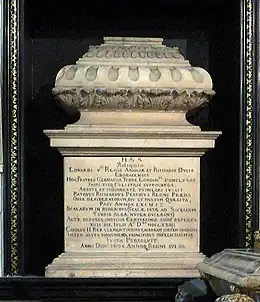
In 1290, Eleanor of Castile, queen of Edward I, died in Nottinghamshire. Over the course of several days, the body was brought to Westminster Abbey, and at each of the places the cortège rested, an Eleanor cross was erected in memory. The most famous of these is Charing Cross, the last stop before the funeral. Eleanor of Castile is buried in the abbey alongside her husband.[45]
In 1483, the boy king Edward V and his brother, Richard (known collectively as the Princes in the Tower), disappeared while preparing for Edward's coronation at the Tower of London. Although it is not known for sure what happened to the boys, historians have suspected their uncle, who became Richard III, of having them murdered. In 1674, the remains of two children were discovered at the Tower, and were buried in Westminster Abbey with royal honours. In 1933, the bones were studied by an anatomist who suggested that they might indeed be the remains of the two princes.[203] Requests to test the DNA of the bones to determine their provenance have been refused, both by the abbey and Queen Elizabeth II, with a spokesperson for the abbey saying, "the mortal remains of two young children [...] should not be disturbed".[204]
Although not a royal funeral, the burial of the Lord Protector Oliver Cromwell took place at the abbey in 1658 with full honours normally only given to monarchs. On top of the coffin lay an effigy of Cromwell complete with crown.[205] After the Restoration of Charles II in 1660, a body thought to be Cromwell's was dug up and thrown in a pit.[206] After the burial of George II in 1760, no royal funeral took place until that of Queen Alexandra, who lay in state in the abbey before being buried in Windsor Castle, in 1926.[76][207]
On 6 September 1997 the formal, though not state funeral of Diana, Princess of Wales, was held at the abbey. In the run-up to the funeral, the railings of the abbey were swamped with flowers and tributes, and the event was more widely witnessed than any previous occasion in the abbey's history, with 2 billion television viewers worldwide.[208] A second public service was held on the following Sunday. The burial occurred privately on 6 September in the grounds of her family estate, Althorp, on a private island.[209]
On 19 September 2022, the state funeral of Elizabeth II took place at the abbey before her burial at St George's Chapel, Windsor.[210] It was the first funeral of a monarch at Westminster Abbey for more than 260 years.[211]
Dean and Chapter
Westminster Abbey is a collegiate church governed by the Dean and Chapter of Westminster, as established by royal charter of Elizabeth I dated 21 May 1560,[212] which created it as the Collegiate Church of St. Peter Westminster, a royal peculiar under the personal jurisdiction of the sovereign.[65] The members of the Chapter are the dean and four canons residentiary;[213] they are assisted by the Receiver General and Chapter Clerk.[214] One of the canons is also Rector of the adjoining St Margaret's Church, Westminster, and often also holds the post of Chaplain to the Speaker of the House of Commons.[215] In addition to the dean and canons, there are at present three full-time minor canons: the precentor, the sacrist and the chaplain.[216] A series of priests vicar assist the minor canons.[216]
King's Almsmen
An establishment of six King's (or Queen's) Almsmen and women is supported by the abbey; they are appointed by royal warrant on the recommendation of the dean and the Home Secretary, attend Matins and Evensong on Sundays and do such duties as may be requested (in return for which they receive a small stipend); when on duty they wear a distinctive red gown with a crowned rose badge on the left shoulder.[217] From the late 18th until the late 20th century the almsmen were usually ex-servicemen, but today they are mostly retired employees of the abbey. Historically, the King's Almsmen and women were retired Crown servants residing in the Royal Almshouse at which existed at Westminster.[218] These were established by Henry VII in connection with his building of the new Lady Chapel, to support the priests of his chantry by offering daily prayer. The Royal Almshouse survived the Dissolution of the Monasteries, but was demolished for road-widening in 1779.[217]
Schools
Westminster School is located in the precincts of the abbey. Teaching certainly took place from the fourteenth century, alongside the monks of the abbey, but the school regards its founder as Elizabeth I, who dissolved the monastery for the final time and provided for the establishment of the school[219] alongside a dean of the abbey, canons, and assistant clergy and lay officers.[220] The schoolboys have added to the history of the abbey, often with their rambunctiousness: Westminster boys have defaced the Coronation Chair, disrupted services, and once interrupted a consecration of four bishops by starting a bare-knuckle fight in the cloisters.[219] One schoolboy carved upon the Coronation Chair that he had slept in overnight, making him probably its longest inhabitant.[221] In 1868, Westminster School became independent of the abbey Dean and Chapter, although the two institutions are still closely connected.[220]
Separately, Westminster Abbey Choir School is also located within the abbey grounds and exclusively educates the choirboys who sing for abbey services.[222]
Music
.jpg.webp)
Andrew Nethsingha has served as Organist and Master of the Choristers since 2023. Peter Holder is the sub-organist, Matthew Jorysz is the assistant organist and Dewi Rees is the current organ scholar.[223]
Choir
Since its foundation in the fourteenth century, the primary role of the Westminster Abbey choir has been to sing for daily services while also playing a central role in many state occasions, including royal weddings and funerals, coronations and memorial services for national and international figures. The choir also pursues a varied programme of recordings, concerts and tours, both nationally and internationally.[224] In 2012, the choir accepted an invitation by Pope Benedict XVI to sing with the Sistine Chapel Choir at a Papal Mass in St. Peter's Basilica.[225] The all-male choir consists of twelve professional adult singers or Lay Vicars, and thirty boy choristers aged between 8 and 13 years-old, who attend the Westminster Abbey Choir School.[226]
Organ
The first record of an organ at Westminster Abbey was a gift of three marks from Henry III in 1240 for the repair of one or more organs.[227] Unum parem organorum ("a pair of organs") was recorded in the Lady Chapel in 1304.[227] An inventory compiled for the Dissolution of the Monasteries in 1540 shows a pair of organs in the choir and one in the Islip Chapel.[227] During the Commonwealth, a Royalist source claimed that soldiers who were billeted in the abbey, "brake downe the Organ, and pawned the pipes at severall Ale-houses for pots of Ale"; however, an organ was played at the Restoration in 1660, suggesting that it was not completely destroyed.[227] In 1720, an organ gifted by George II and built by Christopher Shrider was installed over the choir screen; organs had previously been hidden in the north of the choir. This instrument was fully rebuilt by William Hill & Son in 1848.[227]
A new organ was built by Harrison & Harrison in 1937, with four manuals and 84 speaking stops, and was used publicly for the first time at the coronation of George VI and Elizabeth that year.[228] Some pipework from the previous Hill organ of 1848 was revoiced and incorporated into the new scheme. The two organ cases, designed and built in the late 19th century by J. L. Pearson, were reinstated and coloured in 1959.[229]
In 1982 and 1987 Harrison & Harrison enlarged the organ at the direction of Simon Preston to include an additional lower choir organ and a bombarde organ.[228] The full instrument has five manuals and 109 speaking stops. In 2006 the console of the organ was refurbished by Harrison & Harrison, and space was prepared for two additional 16 ft stops on both the lower choir organ and the bombarde organ.[229] There are three other organs in the abbey, the two-manual Queen’s Organ in the Lady Chapel, a smaller continuo organ and a practice organ.[226]
Bells
The current bells at the Abbey were installed in the north-west tower in 1971.[230] The ring is made up of ten bells, hung for change ringing, that were cast in 1971 by the Whitechapel Bell Foundry and tuned to the notes F#, E, D, C#, B, A, G, F#, E and D. The tenor bell in D (588.5 Hz) has a weight of 30 cwt, 1 qtr, 15 lb (3403 lb or 1544 kg).[231]
In addition, there are two service bells cast by Robert Mot in 1585 and 1598, a sanctus bell cast in 1738 by Richard Phelps and Thomas Lester, and two unused bells — one cast about 1320, and a second cast in 1742 by Thomas Lester.[231] The two service bells and the 1320 bell, along with a fourth small silver "dish bell", kept in the refectory, have been noted as being of historical importance by the Church Buildings Council of the Church of England.[232]
In 1255, the Brethren of the Guild of Westminster had the duty of ringing the bells for a fee of one hundred shillings per annum. A voluntary group, the Westminster Abbey Company of Ringers, was founded in 1921 to continue the tradition.[233]
Order of the Bath

The Most Honourable Order of the Bath is a British order of chivalry whose spiritual home is the Henry VII Chapel in Westminster Abbey. The name derives from the elaborate medieval ceremony for appointing a knight, which involved bathing (as a symbol of purification) as one of its elements.[76] Members are given stalls, complete with their banner, crest and stallplate, at installation ceremonies at the abbey every four years.[234] The order was founded by George I in 1725.[235] There are far many more members than stalls, and so some members wait many years for their installation.[236]
The Order consists of the monarch, the Great Master, and three Classes of members:[237]
- Knight Grand Cross (GCB) or Dame Grand Cross (GCB)
- Knight Commander (KCB) or Dame Commander (DCB)
- Companion (CB)
The Order of the Bath is the fourth-most senior of the British Orders of Chivalry, after The Most Noble Order of the Garter, The Most Ancient and Most Noble Order of the Thistle, and The Most Illustrious Order of St Patrick (dormant).[238]
In popular culture
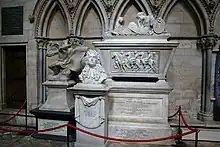
Westminster Abbey is mentioned in the play Henry VIII written by William Shakespeare[239] and John Fletcher, when a gentleman describes the scene of Anne Boleyn's coronation.[240]
The abbey has been mentioned in poetry as early as 1598, in a sonnet by the clergyman Thomas Bastard,[241] which begins "When I behold, with deep astonishment/ To famous Westminster how there restort/ Living in brass or stony monument/ The princes and the worthies of all sort". Poetry about the abbey has also been written by Francis Beaumont[242] and John Betjeman.[243]
The building has appeared in paintings by artists such as Canaletto,[76] Wenceslaus Hollar,[244] William Bruce Ellis Ranken,[245] and J. M. W. Turner.[246]
In 1995, the playwright Alan Bennett produced a documentary called The Abbey, recounting his experiences of the building.[247] Key scenes in the book and film The Da Vinci Code take place in Westminster Abbey.[248] In 2005, the abbey refused filming permission to the producers of the film, calling the book "theologically unsound". Instead, the film uses Lincoln Cathedral as a stand-in for the abbey.[249] The abbey issued a factsheet to their staff to allow them to answer questions from fans that debunked several claims made in the book.[250]
In 2022, it was announced that the abbey had given rare permission for filming inside the church for the untitled eighth Mission: Impossible film.[251]
Notes and references
Notes
- "Dimensions of Westminster Abbey" (PDF). westminster-abbey.org. Archived (PDF) from the original on 4 March 2016. Retrieved 12 January 2016.
- "The Abbey Choir and musicians". Westminster Abbey. Retrieved 9 September 2022.
- Newcomb, Rexford (1997). "Abbey". In Johnston, Bernard (ed.). Collier's Encyclopedia. Vol. I A to Ameland (First ed.). New York, NY: P.F. Collier. pp. 8–11.
- Historic England. "Westminster Abbey (The Collegiate Church of St Peter) (1291494)". National Heritage List for England. Retrieved 9 July 2015.
- Wilkinson & Knighton 2010, p. 69.
- "Coronation live: Charles and Camilla crowned King and Queen at Westminster Abbey". BBC News. 6 May 2023. Retrieved 6 May 2023.
- Wilkinson & Knighton 2010.
- Hassan, Jennifer (8 January 2023). "Royal Treatment". Richmond Times-Dispatch. Archived from the original on 30 January 2023. Retrieved 30 January 2023.
- Page 1909.
- Fernie 2009, pp. 139–143.
- Jenkyns 2004, p. 12.
- Wilkinson & Knighton 2010, pp. 45–47.
- "Palace of Westminster and Westminster Abbey including Saint Margaret's Church". UNESCO World Heritage Centre. Archived from the original on 24 January 2023. Retrieved 30 January 2023.
- Jenkyns 2004, p. 23.
- Carr 1999, p. 24.
- "Westminster Abbey (The Collegiate Church of St Peter), Non Civil Parish – 1291494 | Historic England". Historic England. Archived from the original on 14 May 2022. Retrieved 30 January 2023.
- Wainwright, Oliver (29 May 2018). "'A gothic space rocket to a secret realm' – Westminster Abbey's new £23m tower". The Guardian. Archived from the original on 5 December 2022. Retrieved 24 January 2023.
- Jenkyns 2004, pp. 48–53.
- Castle, Stephen (15 June 2018). "Stephen Hawking Enters 'Britain's Valhalla,' Where Space Is Tight". The New York Times. New York Times. Archived from the original on 2 January 2019. Retrieved 1 January 2019.
- Morris 1900, p. 37.
- Jenkyns 2004, p. 10.
- Cavendish, Richard (12 December 2015). "The consecration of Westminster Abbey". History Today. Retrieved 7 February 2023.
- Jenkyns 2004, p. 11.
- Westlake 1927, pp. 51–52.
- "Flag Days". Westminster Abbey. Archived from the original on 29 May 2023. Retrieved 8 October 2023.
- Wilkinson 2013, p. 6.
- Corrigan 2018, p. 148.
- Corrigan 2018, p. 159.
- Harvey 1993, p. 2.
- Stafford 2009, p. 137.
- Carr 1999, p. 2.
- "Harold returns to Edward". Reading Museum. 20 January 2021. Retrieved 24 April 2023.
- Trowles 2008, p. 8.
- Wilkinson & Knighton 2010, p. 11.
- Harvey 1993, p. 6.
- Harvey 1993, p. 5.
- Harvey 1993, p. 5-6.
- Jenkyns 2004, p. 27.
- Wilkinson & Knighton 2010, p. 16.
- Wilkinson & Knighton 2010, p. 17.
- Corrigan 2018, p. 56.
- Wilkinson & Knighton 2010, pp. 17–18.
- Corrigan 2018, p. 41.
- Wilkinson & Knighton 2010, p. 7.
- Wilkinson & Knighton 2010, p. 23.
- Wilkinson 2013, p. 41.
- Trowles 2008, p. 10.
- Royal Commission on Historical Monuments (England) 1924.
- Wilkinson & Knighton 2010, pp. 27–29.
- Wilkinson & Knighton 2010, pp. 30–33.
- Trowles 2008, p. 11.
- Peacock, Edward (January 1894). "King Henry VI.: Proceedings relating to his Proposed Canonization". The Antiquary. 29: 18–21. ProQuest 6570310.
- Jenkyns 2004, p. 53.
- Rodwell 2010, p. 17.
- Rodwell 2010, pp. 23–28.
- Jenkyns 2004, p. 34.
- Jenkyns 2004, p. 13.
- Wilkinson & Knighton 2010, p. 43.
- Harvey 2007.
- Wilkinson & Knighton 2010, p. 44.
- Dixon 1908.
- Horn 1992, pp. 65–67.
- Jenkyns 2004, p. 56.
- Brewer 2001, p. 923.
- "England by Diocese". Anglicans online. Archived from the original on 28 July 2018. Retrieved 28 July 2018.
- "Westminster School". London Remembers. Retrieved 24 April 2023.
- "HM The Queen attends King James Bible Service". Westminster Abbey. 16 November 2011. Archived from the original on 28 July 2018. Retrieved 28 July 2018.
- Wilkinson & Knighton 2010, p. 53.
- Jenkyns 2004, p. 64.
- Ashley, Maurice; Morrill, John S. "Oliver Cromwell: Administration As Lord Protector". Encyclopaedia Britannica. Archived from the original on 21 February 2023. Retrieved 2 March 2023.
- Wilkinson 2013, p. 19.
- Wilkinson 2013, p. 16.
- "Nicholas Hawksmoor". Westminster Abbey. Archived from the original on 7 July 2018. Retrieved 28 July 2018.
- Thornbury 1878, pp. 401–411.
- Black 2007, p. 253.
- Wilkinson & Knighton 2010, p. 57.
- Wilkinson 2013, pp. 16–18.
- Jenkyns 2004, p. 113.
- Scott 1863, pp. 41–43, 56–58.
- Jenkyns 2004, p. 154.
- Lutyens, Edwin Landseer (1943). "Preliminary designs for a proposed narthex for Westminster Abbey". Royal Institute of British Architects. Archived from the original on 28 November 2022. Retrieved 1 October 2022.
- Webb 2014, p. 148.
- Walker, Rebecca (2020). "Deeds, Not Words: The Suffragettes and Early Terrorism in the City of London". The London Journal. 45 (1): 59. doi:10.1080/03058034.2019.1687222. ISSN 0305-8034. S2CID 212994082.
- Jones 2016, p. 65.
- Riddell, Fern (6 February 2018). "Suffragettes, violence and militancy". The British Library. Archived from the original on 30 December 2022. Retrieved 2 October 2021.
- Bearman, C. J. (2005). "An Examination of Suffragette Violence". The English Historical Review. 120 (486): 378. doi:10.1093/ehr/cei119. ISSN 0013-8266. JSTOR 3490924.
- "General Structure of the Abbey Intact". The Scotsman. 13 May 1941. p. 5. Retrieved 31 January 2023.
- "Famous London buildings severely damaged". Irish Independent. 12 May 1941. p. 5. Retrieved 31 January 2023.
- "Westminster Abbey: £135,000 Damage in Raids". Belfast News-Letter. 17 May 1941. p. 6. Retrieved 31 January 2023.
- Wilkinson 2013, p. 22.
- "Westminster Abbey now example of how to handle tourists". Episcopal News Service. 6 March 2002. Archived from the original on 18 September 2017. Retrieved 18 September 2017.
- Jenkyns 2004, p. 112.
- "Building work announced for Abbey". BBC News. 28 June 2009. Archived from the original on 20 October 2022. Retrieved 29 June 2009.
- Kennedy, Maev (29 June 2009). "Dean lines up new crown shaped roof for Westminster Abbey". The Guardian. Archived from the original on 4 December 2013. Retrieved 29 June 2009.
- "Abbey Development Plan Update". Westminster Abbey. 4 August 2010. Archived from the original on 9 August 2010. Retrieved 7 September 2010.
- "Cosmati pavement". Westminster Abbey. Archived from the original on 15 May 2013. Retrieved 16 June 2013.
- Schjonberg, Mary Frances (17 September 2010). "Benedict becomes first pope to visit Lambeth, Westminster Abbey". Episcopal Life Online. Archived from the original on 11 June 2011. Retrieved 17 September 2010.
- "Newsbeat – Royal wedding: Prince William and Kate Middleton marry". BBC. 29 April 2011. Archived from the original on 2 May 2011. Retrieved 8 January 2012.
- "The Queen opens The Queen's Diamond Jubilee Galleries with the Prince of Wales". Royal.UK. 8 June 2018. Archived from the original on 28 July 2018. Retrieved 28 July 2018.
- Brown, Mark (23 August 2020). "Lost medieval sacristy uncovered at Westminster Abbey". The Guardian. Archived from the original on 15 December 2022. Retrieved 24 January 2023.
- Vanderhoof, Erin (23 March 2021). "Kate and William Visit One of the U.K.'s Most Surprising Vaccination Clinics". Vanity Fair. Archived from the original on 24 June 2022. Retrieved 24 January 2023.
- "Field Trip: Building Stones of Westminster Abbey". ougs.org. Retrieved 24 April 2023.
- Trowles 2008, p. 45.
- Wilkinson 2013, p. 43.
- Trowles 2008, p. 160.
- Trowles 2008, p. 161.
- Kennedy, Maev (14 December 2016). "New tower will reveal hidden world of Westminster Abbey". The Guardian. Archived from the original on 24 January 2023. Retrieved 24 January 2023.
- Wilkinson 2013, p. 10.
- Trowles 2008, p. 24.
- Trowles 2008, p. 99.
- Trowles 2008, p. 31.
- Trowles 2008, pp. 31–32.
- Trowles 2008, p. 15.
- Jenkyns 2004, pp. 43–44.
- Westlake 1927, p. 169.
- Wilkinson 2013, p. 18.
- Trowles 2008, p. 71.
- Wilkinson 2013, p. 17.
- Jenkyns 2004, p. 190.
- Jenkyns 2004, p. 57.
- Wilkinson 2013, p. 20.
- Trowles 2008, pp. 60–66.
- Trowles 2008, p. 61.
- Trowles 2008, p. 53.
- Trowles 2008, pp. 75–79.
- Trowles 2008, p. 80.
- Trowles 2008, p. 97.
- Wilkinson 2013, p. 40.
- "Chapter house and Pyx Chamber". English Heritage. Archived from the original on 28 July 2018. Retrieved 28 July 2018.
- Trowles 2008, p. 154.
- Historic England. "The Chapter House and Pyx Chamber in the abbey cloisters, Westminster Abbey (1003579)". National Heritage List for England. Retrieved 20 January 2017.
- Noppen, J. G. (1932). "The Westminster Apocalypse and Its Source". The Burlington Magazine for Connoisseurs. 61 (355): 146–159. ISSN 0951-0788. JSTOR 865080.
- Atom (17 June 2022). "Ancient history: Britain's oldest door –". aijmagazine.co.uk. Retrieved 24 April 2023.
- "Henry VII Chapel". Smarthistory. Archived from the original on 29 September 2022. Retrieved 5 February 2023.
- Trowles (2008); p. 126
- Lindley 2003, p. 208.
- Jenkyns 2004, pp. 60–61.
- Trowles 2008, p. 127.
- Wilkinson 2013, p. 25.
- Carr 1999, p. 4.
- Trowles 2008, p. 159.
- Westlake 1927, pp. 50–55.
- Westlake 1927, p. 56.
- Trowles 2008, p. 120.
- Carr 1999, p. 21.
- Wenn, James. "Revealed: Secrets in the Stones: Decoding Anglo-Saxon Art. Part 4: The Garnet Code". www.thegns.org. Retrieved 24 April 2023.
- Trowles 2008, p. 23.
- Jenkyns 2004, p. 35.
- Trowles 2008, p. 96.
- Westlake 1927, pp. 162–164.
- Wilkinson 2013, p. 9.
- Jenkyns 2004, p. 149.
- Heller, Jenny E. (22 September 1998). "Westminster Abbey Elevates 10 Foreigners". The New York Times. Archived from the original on 19 August 2016. Retrieved 21 July 2016.
- Streeter, Michael (17 October 1997). "Heritage: Westminster Abbey prepares modern martyrs' corner". The Independent. Archived from the original on 20 August 2016. Retrieved 21 July 2016.
- Ross, Peter. "The Grand History of Westminster Abbey". Smithsonian Magazine. Archived from the original on 15 April 2023. Retrieved 16 April 2023.
- Grierson, Jamie (24 March 2023). "Public invited to walk on Westminster Abbey's Cosmati pavement – in socks". The Guardian. ISSN 0261-3077. Retrieved 24 April 2023.
- Jenkyns 2004, pp. 36–39.
- Trowles 2008, p. 16.
- Trowles 2008, pp. 27–28.
- Fawcett 1998, p. 53.
- Austin, Sue (21 April 2023). "Revealed: Links between Shropshire country hall and the King's Coronation". www.shropshirestar.com. Retrieved 24 April 2023.
- Forster, R (1991). "Patterns of thought : the hidden meaning of the great pavement of Westminster Abbey". www.semanticscholar.org. S2CID 190842468. Retrieved 24 April 2023.
- Austin, Sue (21 April 2023). "Revealed: Links between Shropshire country hall and the King's Coronation". www.shropshirestar.com. Retrieved 24 April 2023.
- Austin, Sue (21 April 2023). "Revealed: Links between Shropshire country hall and the King's Coronation". www.shropshirestar.com. Retrieved 24 April 2023.
- Wenn, James. "Revealed: Secrets in the Stones: Decoding Anglo-Saxon Art. Part 4: The Garnet Code". www.thegns.org. Retrieved 24 April 2023.
- Wilkinson 2013, p. 7.
- Jenkyns 2004, p. 148.
- Reynolds 2002, p. 4.
- Reynolds 2002, p. 24.
- Reynolds 2002, p. 10.
- Brown, Mark (26 September 2018). "David Hockney unveils iPad-designed window at Westminster Abbey". The Guardian. Archived from the original on 24 January 2023. Retrieved 24 January 2023.
{{cite web}}: CS1 maint: bot: original URL status unknown (link) - Trowles 2008, p. 156
- Wilkinson & Knighton 2010, pp. 51–52.
- "Queen portrait unveiled in Australia". BBC News. 29 September 2012. Retrieved 23 January 2023.
- Wilkinson & Knighton 2010, p. 52.
- Zakir-Hussain, Maryam (20 September 2022). "Royal Vault: Inside the Burial Chamber That Houses 25 Royals". The Independent. Archived from the original on 5 March 2023. Retrieved 5 March 2023.
- McCabe, Sophie (2 March 2023). "Frogmore Cottage, the hideaway long used to shelter embattled royals". Express.co.uk. Archived from the original on 3 March 2023. Retrieved 5 March 2023.
- Jenkyns 2004, p. 63.
- Jenkyns 2004, p. 83.
- Murray Smith 1906.
- Jenkyns 2004, pp. 150–154.
- Jenkyns 2004, pp. 75–78.
- "History of Modern Cremation in Great Britain from 1874: The First Hundred Years". The Cremation Society of Great Britain. 1974. Archived from the original on 3 August 2010. Retrieved 28 November 2010.
- "Sebastian Charles". Westminster Abbey. Archived from the original on 22 December 2015. Retrieved 19 September 2015.
- "Elizabeth, Duchess of Northumberland & Percy family". Westminster Abbey. Archived from the original on 31 December 2015. Retrieved 30 September 2013.
- Jenkyns 2004, pp. 78–81.
- Wilkinson & Knighton 2010, p. 79.
- Wilkinson 2013, p. 37.
- Jenkyns 2004, pp. 171–172.
- Wilkinson & Knighton 2010, p. 29.
- Wilkinson & Knighton 2010, p. 35.
- Wilkinson & Knighton 2010, p. 65.
- Jenkyns 2004, p. 167.
- Robinson 1992, p. ix.
- Wilkinson & Knighton 2010, p. 61.
- Wilkinson & Knighton 2010, p. 15.
- Wilkinson 2013, p. 11.
- "Stone of Destiny heads south for coronation". BBC News. 28 April 2023. Retrieved 8 October 2023.
- Trowles 2008, p. 68.
- Wilkinson & Knighton 2010, p. 62.
- Jenkyns 2004, p. 174.
- "HRH Prince William of Wales and Miss Catherine Middleton to Wed at Abbey". Westminster Abbey. Archived from the original on 26 March 2011. Retrieved 25 December 2018.
- Wilkinson & Knighton 2010, p. 36.
- Travis, Alan (5 February 2013). "Why the Princes in the Tower are staying six feet under". The Guardian. ISSN 0261-3077. Retrieved 8 April 2023.
- Wilkinson & Knighton 2010, p. 54.
- Terri Schlichenmeyer (21 August 2007). "Missing body parts of famous people". CNN. Archived from the original on 15 September 2020. Retrieved 27 November 2008.
- "A History of Royal Burials and Funerals". www.westminster-abbey.org. Dean and Chapter of Westminster. Retrieved 9 April 2023.
- Wilkinson & Knighton 2010, p. 80.
- "Diana Returns Home". BBC News. 1997. Archived from the original on 25 October 2016. Retrieved 21 July 2016.
- Foster, Max; McGee, Luke; Owoseje, Toyin (19 September 2022). "Who's on the guest list for Queen Elizabeth II's state funeral?". CNN. Archived from the original on 21 September 2022. Retrieved 19 September 2022.
- Hirwani, Peoni (19 September 2022). "The significance of Westminster Abbey, where the Queen's funeral service is taking place". www.independent.co.uk. Independent Digital News and Media Limited. Retrieved 9 April 2023.
- Westminster Abbey and Saint Margaret Westminster Act 1972. London, UK: HMSO. 1972. p. 1.
- "John Hall to be Dean of Westminster". Church Times. 2 November 2006. Archived from the original on 28 July 2018. Retrieved 28 July 2018.
- "Sir Stephen Lamport". Asian Women of Achievement. Archived from the original on 28 July 2018. Retrieved 28 July 2018.
- "Interview: Robert Wright, Sub-dean of Westminster Abbey, Rector of St Margaret's". Church Times. 26 May 2009. Archived from the original on 28 July 2018. Retrieved 28 July 2018.
- "Royal Appointments". Crockfords Clerical Directory. Archived from the original on 28 July 2018. Retrieved 28 July 2018.
- Fox, Christine Merie (2012). The Royal Almshouse at Westminster c.1500-c.1600 (PDF). pp. 248–250. Archived (PDF) from the original on 10 October 2022.
- Fox, Christine Merie (2013). The Royal Almshouse at Westminster, c.1500- c.1600 (PhD thesis). Royal Holloway, University of London.
- Jenkyns 2004, pp. 56–57.
- Trowles 2008, p. 12.
- Jenkyns 2004, p. 65.
- "Making all the right noises: An Interview with Jonathan Milton, headmaster of the Westminster Abbey Choir School". KCW Today. 15 September 2017. Archived from the original on 10 January 2019. Retrieved 28 July 2018.
- Westminster Abbey: The Abbey Choir and musicians. Retrieved 15 May 2023.
- "The Abbey Choir and Musicians - The Choir". www.westminster-abbey.org. Dean and Chapter of Westminster. Retrieved 3 October 2023.
- "Choir of Westminster Abbey invited to sing at Vatican". The Times. 8 October 2023. ISSN 0140-0460. Retrieved 8 October 2023.
- Shaw Roberts, Maddy (5 May 2023). "Music at Westminster Abbey – who are the choristers and organists, and what services are there?". www.classicfm.com. Classic FM / Global Media & Entertainment Ltd. Retrieved 3 October 2023.
- Knight, David Stanley (2001). The Organs of Westminster Abbey and their Music, 1240-1908 (Doctoral thesis). King's College London.
- "Westminster Abbey" (PDF). Harrison & Harrison. Retrieved 24 April 2023.
- "Westminster Abbey (St. Peter), Broad Sanctuary, Westminster, Middlesex [N00646]". The National Pipe Organ Register. Archived from the original on 20 October 2022. Retrieved 31 July 2012.
- Trowles 2008, p. 123.
- "Westminster, Greater London, Collegiate Ch of S Peter". Dove's Guide for Church Bell Ringers. Archived from the original on 16 August 2019. Retrieved 6 March 2023.
- "Westminster Abbey Church Heritage Record". Church of England. Archived from the original on 6 March 2023. Retrieved 6 March 2023.
- "Abbey bells". www.westminster-abbey.org. Dean and Chapter of Westminster. Retrieved 31 May 2023.
- Ducker 2004, p. 22.
- Ducker 2004, p. 20.
- Wilkinson & Knighton 2010, p. 78.
- Statutes of the Most Honourable Order of the Bath. Harrison and Sons. 1925.
- Squibb, George Drewry (1981). Precedence in England and Wales. Oxford: Clarendon Press. pp. 393–394. ISBN 9780198253891.
- "Henry VIII (complete text) :|: Open Source Shakespeare". www.opensourceshakespeare.org. Retrieved 24 April 2023.
- Jenkyns 2004, pp. 170–171.
- "The Sketch Book of Geoffrey Crayon, Gent. by Washington Irving". www.gutenberg.org. Retrieved 24 April 2023.
- Jenkyns 2004, p. 125.
- Jenkyns 2004, pp. 190–191.
- "Wenceslaus Hollar (1607–77) – Westminster Abbey". www.rct.uk. Retrieved 5 February 2023.
- "Interior of Westminster Abbey, Arranged for the Coronation, 1937 | Art UK". artuk.org. Retrieved 5 February 2023.
- "The Burning of the Houses of Lords and Commons, October 16, 1834". philamuseum.org. Retrieved 5 February 2023.
- "Bennett, Alan (1934-)". BFI Screenonline. Retrieved 8 October 2023.
- Brown, Dan (2003). The Da Vinci code: a novel. New York. ISBN 978-0-385-50420-1. OCLC 50920659.
{{cite book}}: CS1 maint: location missing publisher (link) - "Westminster Abbey closes doors to Da Vinci Code". The Guardian. 1 June 2005. Archived from the original on 24 January 2023. Retrieved 24 January 2023.
- "Westminster Abbey counters Da Vinci Code". The Guardian. 31 May 2005. Archived from the original on 24 January 2023. Retrieved 24 January 2023.
- Duff, Seamus (9 July 2022). "Mission Impossible makes history for being allowed to film in Westminster Abbey". mirror. Retrieved 24 January 2023.
References
- Black, Jeremy (2007). George II: Puppet of the Politicians?. Exeter: University of Exeter Press. ISBN 978-0859898072.
- Bradley, Simon; Pevsner, Nikolaus (2003). The Buildings of England – London 6: Westminster. New Haven: Yale University Press. ISBN 0711710678.
- Brewer, Ebenezer Cobham (2001). Wordsworth Dictionary of Phrase and Fable. Ware, Hertfordshire: Wordsworth Editions. ISBN 978-1840223101.
- Carr, Wesley (1999). Westminster Abbey. Norwich: Jarrold. ISBN 0300095953. Retrieved 8 October 2023.
- Corrigan, Imogen (2018). Stone on Stone: The Men Who Built The Cathedrals. Ramsbury, Marlborough: Robert Hale. ISBN 978-0719827983.
- Dixon, H. Claiborne (1908). The Abbeys of Great Britain. London: T. W. Laurie. OCLC 778287774.
- Ducker, Peter (2004). British Orders and Decorations. Princes Risebrough, Buckinghamshire: Shire Publishing. ISBN 0-7478-0580-6.
- Fernie, Eric (2009). "Edward the Confessor's Westminster Abbey". In Mortimer, Richard (ed.). Edward the Confessor: The Man and the Legend. Suffolk: Boydell & Brewer. ISBN 978-1-84615-716-5.
- Fawcett, Jane (1998). Historic Floors (First ed.). London: Faylor & Francis. ISBN 978-1136398568.
- Gem, Richard (2009). "Craftsmen and Administrators in the Building of the Confessor's Abbey". In Mortimer, Richard (ed.). Edward the Confessor: The Man and the Legend. Suffolk: Boydell & Brewer. ISBN 978-1-84615-716-5.
- Harvey, Barbara (1993). Living and Dying in England 1100–1540: The Monastic Experience. Oxford: Clarendon Press. ISBN 978-1861976482. Retrieved 8 October 2023.
- Harvey, Barbara (22 November 2007). The Dissolution and Westminster Abbey. Special Centenary Conference of the English Benedictine Congregation. Archived from the original on 15 October 2018. Retrieved 2 March 2023.
- Horn, Joyce M. (1992). Fasti Ecclesiae Anglicanae 1541–1857. Vol. 7: Ely, Norwich, Westminster and Worcester Dioceses. London: Institute of Historical Research. OCLC 940336626. Retrieved 2 March 2023.
- Jenkyns, Richard (2004). Westminster Abbey: A Thousand Years of National Pageantry. London: Profile Books. ISBN 1846685346. Retrieved 8 October 2023.
- Jones, Ian (2016). London: Bombed Blitzed and Blown Up: The British Capital Under Attack Since 1867. Barnsley, South Yorkshire: Frontline Books. ISBN 978-1473879010.
- Lindley, Phillip (2003). "Henry VII Chapel, Westminster Abbey". In Making Medieval Art. Donington: Shaun Tyas. ISBN 1-900289-59-8.
- Morris, William (1900). Architecture and History and Westminster Abbey. London: Longmans & Co. OCLC 898997220. Retrieved 2 March 2023.
- Morton, Henry Vollam (1988) [1951]. In Search of London. London: Methuen. ISBN 978-0711724365.
- Murray Smith, Mrs A. (1906). Westminster Abbey. London: Cassell. OCLC 3382350. Archived from the original on 9 November 2012. Retrieved 5 March 2023.
- Page, William (1909). "Benedictine Monks: St Peter's Abbey, Westminster". A History of the County of London: Volume 1, London Within the Bars, Westminster and Southwark. London: Victoria County History. ISBN 0413184706.
- Reynolds, Christine (2002). Stained Glass of Westminster Abbey. Great Britain: Jarrold. ISBN 0413184706. Retrieved 8 October 2023.
- Robinson, Brian (1992). Silver Pennies & Linen Towels: The Story of the Royal Maundy. London: Spink & Sons Ltd. ISBN 978-0907605355.
- Rodwell, Warwick (2009). "New Glimpses of Edward the Confessor's Abbey at Westminster". In Mortimer, Richard (ed.). Edward the Confessor: The Man and the Legend. Suffolk: Boydell & Brewer. ISBN 978-1-84615-716-5.
- Rodwell, Warwick (2010). The Lantern Tower of Westminster Abbey, 1060-2010: Reconstructing its History and Architecture. Oxford: Oxbow Books. ISBN 978-1842179796. JSTOR j.ctt1cfr93k.
- Royal Commission on Historical Monuments (England) (1924). An Inventory of the Historical Monuments in London. Vol. 1, Westminster Abbey. London: His Majesty's Stationery Office. OCLC 59377442. Archived from the original on 9 December 2022. Retrieved 2 March 2023.
- Scott, George Gilbert (1863). Gleanings from Westminster Abbey. Oxford: J. Henry and J. Parker. OCLC 256101.
- Stafford, Pauline (2009). "Edith, Edward's Wife and Queen". In Mortimer, Richard (ed.). Edward the Confessor: The Man and the Legend. Suffolk: Boydell & Brewer. ISBN 978-1-84615-716-5.
- Thornbury, Walter (1878). "Westminster Abbey: Historical Ceremonies". Old and New London. Vol. 3. London: Cassell, Petter & Galpin. OCLC 10552904. Archived from the original on 16 October 2022.
- Trowles, Tony (2008). Treasures of Westminster Abbey. London: Scala. ISBN 978-1857594546.
- Webb, Simon (2014). The Suffragette Bombers: Britain's Forgotten Terrorists. Barnsley, South Yorkshire: Pen and Sword. ISBN 978-1783400645. Retrieved 8 October 2023.
- Westlake, Herbert Francis (1927). Story of Westminster Abbey. London: Philip Allan & Co. OCLC 3251401.
- Wilkinson, James; Knighton, Charles S. (2010). Crown and Cloister: The Royal Story of Westminster Abbey. London: Scala Publishers. ISBN 9781857596281. Retrieved 8 October 2023.
- Wilkinson, James (2013). Westminster Abbey: A Souvenir Guide (Revised ed.). London: Scala Arts & Heritage Publishers. ISBN 978-1857598216.

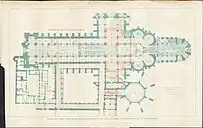
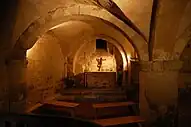
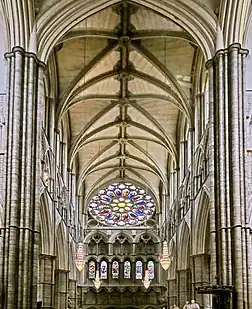
_05.jpg.webp)
